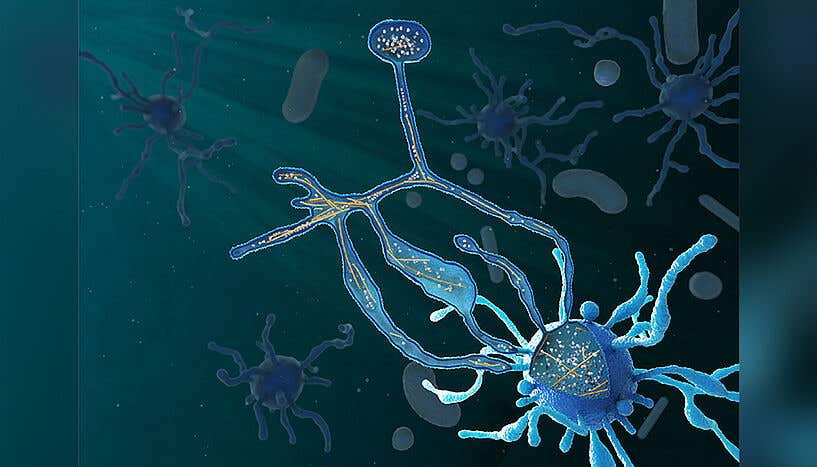Novel ‘origin of life’ research shows that we’re all Asgardians
The fabled Norse god Thor, along with his mythological city of Asgard, have left a formidable imprint on our cultural memory.

[July 26, 2023: Staff Writer, The Brighter Side of News]
Cryo-electron tomography provided insight into the cellular structure of a newly cultured Asgard archaeon. (CREDIT: Margot Riggi)
The fabled Norse god Thor, along with his mythological city of Asgard, have left a formidable imprint on our cultural memory. But according to a seminal study, it now seems that the legacy of Asgard extends far beyond the annals of folklore.
The groundbreaking research, published in the esteemed journal Nature, has revealed a fascinating connection between the mythological city of Asgard and the genesis of life on Earth. The study presents evidence suggesting that all complex organisms on Earth — encompassing humans, eagles, starfish, daisies, and the full spectrum of life forms with nuclei in their cells — share a common ancestor: an ancient group of microbes known as Asgard archaea.
In a breakthrough revelation, researchers from The University of Texas at Austin, in collaboration with international institutions, have unearthed the origins of eukaryotes — complex organisms characterized by cells with nuclei. The results of the meticulous genomic analysis of hundreds of archaea species point to the existence of a shared ancestor with Asgard archaea.
In the context of evolutionary biology, eukaryotes form a "well-nested clade" within Asgard archaea, mirroring how birds are one of several groups within a larger collective called dinosaurs, all tracing their lineage back to a shared progenitor.
Related Stories
Dr. Brett Baker, an Associate Professor of Integrative Biology and Marine Science at UT Austin, highlights the importance of this revelation. "So, what events led microbes to evolve into eukaryotes? That's a big question. Having this common ancestor is a big step in understanding that," he said.
This transformative research was spearheaded by Thijs Ettema of Wageningen University in the Netherlands. The team identified the Hodarchaeales, a newly classified order of microbes found in marine sediments, as the closest microbial relative to all complex life forms. This novel classification — Hods, for short — is one of several subsets within the larger Asgard archaea group.
The Asgard archaea, whose origins can be traced back over two billion years, have managed to survive into the present. Their descendants have been found in deep sea sediments and hot springs scattered across the globe, although successful cultivation of these microorganisms in the lab has been limited to just two strains.
The identification of these elusive microbes hinges on the collection of their genetic material from the environment and the assembly of their genomes. Based on genetic similarities with other organisms that have been cultivated and studied in the lab, researchers can infer the metabolic traits and other characteristics of the Asgards.
Phylogenomic analysis of 15 concatenated ribosomal proteins expands Asgard archaea diversity. (CREDIT: Nature)
Valerie De Anda, a researcher in Dr. Baker’s lab, metaphorically described the process. "Imagine a time machine, not to explore the realms of dinosaurs or ancient civilizations, but to journey deep into the potential metabolic reactions that could have sparked the dawn of complex life," De Anda said. "Instead of fossils or ancient artifacts, we look at the genetic blueprints of modern microbes to reconstruct their past."
Expanding on the known Asgard genomic diversity, the researchers added more than 50 previously undescribed Asgard genomes into their analytical model. Their findings propose that the ancestor of all modern Asgards dwelled in hot environments, subsisting on carbon dioxide and other chemicals. In contrast, the Hods, which bear a closer relation to eukaryotes, show metabolic similarities to modern complex organisms, consuming carbon and thriving in cooler climes.
Asgard archaea form a group with the eukaryotes in the tree of life. (CREDIT: Eva Fernandez-Caceres)
De Anda conveyed the excitement of the team. "This is really exciting because we are looking for the first time at the molecular blueprints of the ancestor that gave rise to the first eukaryotic cells," she expressed.
The name Hodarchaeales pays homage to the god Hod, a figure in Norse mythology who is famously known as the blind son of Odin and Frigg. He was deceived into causing the death of his own brother, Baldr.
The association with Norse mythology isn’t lost on Dr. Baker. "I keep joking in my talks that 'We are all Asgardian'," he quipped. "Now that's probably going to be on my tombstone."
In addition to Baker, Kiley W. Seitz and Nina Dombrowski represented UT Austin as co-authors on the research paper. The international team included prominent names like Laura Eme, Daniel Tamarit, Eva Caceres, Courtney Stairs, Max Schön, William Lewis, Felix Homa, Jimmy Saw, Jonathan Lombard, Takuro Nunoura, Wen-Jun Li, Zheng-Shuang Hua, Lin-Xing Chen, Jillian Banfield, Emily St. John, Anna-Louise Reysenbach, Matthew Stott, Andreas Schramm, Kasper Kjeldsen, and Andreas Teske.
Asgard archaea encode homologs of eukaryotic protein complexes involved in N-glycosylation. (CREDIT: Nature)
The research was funded by an assortment of sources, including the Origin of Eukaryotes program at the Moore and Simons Foundations, the U.S. National Science Foundation, the Wellcome Trust Foundation, the European Research Council, the Swedish Research Council, the Dutch Research Council, the National Natural Science Foundation of China, the Wenner-Gren Foundation, the Science for Life Laboratory (Sweden), and the European Commission’s Marie Skłodowska-Curie Actions.
Baker elucidated the importance of these findings: "To me, the most exciting thing is that we're starting to see the transition from what biologists think is an archaeon to this organism Hodarchaeales that is more like a eukaryote," he explained. He further expounded, "Another way to put it is that these Hods are our sister group in the archaeal world."
Schematic representation of a eukaryotic cell in which ESPs involved in membrane trafficking and endosomal sorting that have been identified in Asgard archaea are highlighted. Colored subunits have been detected in some Asgard archaea while grey ones seem to be absent from all current representatives. (CREDIT: Nature)
The research team postulates that the Asgard archaea lineage, which displays an abundance of genes with multiple copies, were the progenitors of eukaryotes. The process of gene duplication in eukaryotes often led to new gene functions, granting organisms new abilities and driving evolution.
"We don't know, in these Asgards specifically, what the gene duplications led to," Baker explained. "But we know in eukaryotes that gene duplications led to new functions and an increasing of cellular complexity. So, we think that that's one of the ways that Asgards led to the innovations that define eukaryotes."
Many proteins once thought to be exclusive to eukaryotes have been discovered in archaea. Baker asserted that understanding these simpler life forms and their eukaryotic characteristics could provide invaluable insights about ourselves.
With this groundbreaking study, our understanding of the lineage of complex life has taken a leap forward. Unraveling the genetic blueprint of our microbial ancestors could provide essential clues about the evolutionary milestones that led to the diversity of life as we know it. And in doing so, it seems that we, along with the rest of the complex life on Earth, can, in a sense, call ourselves 'Asgardians'.
Note: Materials provided above by The Brighter Side of News. Content may be edited for style and length.
Like these kind of feel good stories? Get the Brighter Side of News' newsletter.



